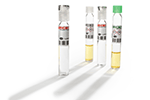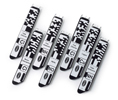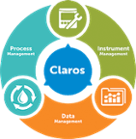-
Produkty
- Przyrządy laboratoryjne
-
Mierniki i elektrody laboratoryjne
Wzorce do kalibracji Mierniki i sondy Sension+
- Chemikalia, reagenty i wzorce
-
Online Analysers
Analizatory azotu amonowego
- Analizatory azotu amonowego NH6000sc
- System FX610/FX620
- System Filtrax
- Odczynniki do NH6000sc
- Amtax sc
- CL17sc
- Amperometryczny CL10 sc
- Amperometryczny 9184 sc
- Analizator kolorymetryczny chloru CL17sc do pomiarów bardzo niskiego zakresu
Analizatory serii EZ- Żelazo
- Aluminium
- Mangan
- Fosforany
- Chlorki
- Cyjanki
- Fluorki
- Siarczany
- Siarczki
- Arsen
- Chrom
- Miedź
- Nikiel
- Cynk
- Azot amonowy
- Azot całkowity
- Fosfor całkowity
- Fenol
- Lotne kwasy tłuszczowe
- Zasadowość
- ATP
- Twardość
- Toksyczność
- Preparowanie próbek
- Boron
- Colour
- Nitrate
- Nitrite
- Silica
- Hydrogen Peroxide
- EZ Series Reagents
- EZ Series Accessories
-
Czujniki i regulatory online
Przetworniki cyfrowe Przetworniki (analogowe) Ammonium Sensors Czujnik do monitorowania siarkowodoruCzujniki pH i ORP
- 12 mm pH/Redox
- 1200-S Redox
- 1200-S pH
- Cyfrowa dyferencyjna ORP
- Cyfrowa dyferencyjna pH
- Dyferencyjna pH
- Kombinowana pH/ORP
- LCP ORP
- LCP pH/ORP
- 9525 DCCP System
- Analogowa indykcyjna 3700
- Analogowa kontaktowa 3400
- Bezelektrodowa 3798 sc
- Cyfrowa kontaktowa 3400
- Przewodność kationowa 9523
- Automatyczne systemy laboratoryjne
- Claros Water Intelligence System
-
Mikrobiologia
Akcesoria i chemikalia Gotowe pożywkiPożywki odwodnione Sprzęt laboratoryjny
- Pobieranie próbek
- Zestawy i paski testowe
-
Wyposażenie laboratoryjne i dostawy
Książki i materiały referencyjne Ogólnie materiały eksploatacyjne do laboratoriumWyroby szklane/Wyroby z tworzyw sztucznych
- Elektrochemia
- PARAMETRY
-
Rozwiązania softwarowe
-
Claros Water Intelligence System
Główne produkty Process Management
- Rozwiązania do:
- Usuwania związków węgla organicznego/ChZT
- Denitryfikacji naprzemiennej
- Usuwania fosforu
- Gospodarki osadami
Data Management- Rozwiązania do:
- Gromadzenia
- Wizualizacji i analizy
- Raportowania
- Zapewniania dokładności
Instrument Management- Rozwiązania do:
- Konserwacji
- Rozwiązywania problemów
- Dostępu zdalnego
- Porównywania metod laboratoryjnych i procesów
-
Claros Water Intelligence System
- Branże
- Serwis
- Nowości i wydarzenia
Nitryfikacja/denitryfikacja. Pod kontrolą.
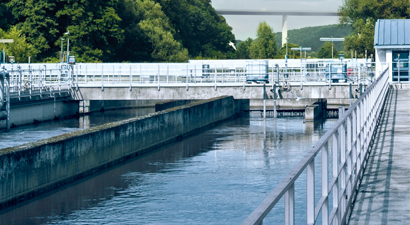 |
System RTC-N firmy Hach reguluje proces nitryfikacji i denitryfikacji w czasie rzeczywistym, pomagając spełniać limity kontroli amoniaku i azotanów, redukując koszty nadmiernego i niepotrzebnego napowietrzania. |
System gotowy do natychmiastowego użycia
RTC jest systemem typu włącz i pracuj, który jest gotowy do użycia po bardzo prostej konfiguracji. Instalacja systemu wymaga minimalnego przestoju i po jej zakończeniu firma Hach pomaga zaprogramować punkt nastawy, dzięki czemu jesteś zawsze przygotowany do monitorowania i oczyszczania wody w czasie rzeczywistym.
Redukcja kosztów oczyszczania
The RTC-N/DN module is preprogrammed with algorithms that adjust blowers to maintain your desired DO setpoint based on ammonia and nitrate levels. By treating only when needed, you save on energy costs.
Kiedy mówimy serwis, mamy na myśli serwis!
Pełny pakiet serwisowy Hach obejmuje rutynowe wizyty konserwacyjne i naprawy gwarancyjne. Zespół zdalnych ekspertów technicznych będzie monitorował system i wyśle raporty, aby system działał prawidłowo. To tak, jakby technik z Hach był obecny w zakładzie.
Zachowaj zgodność
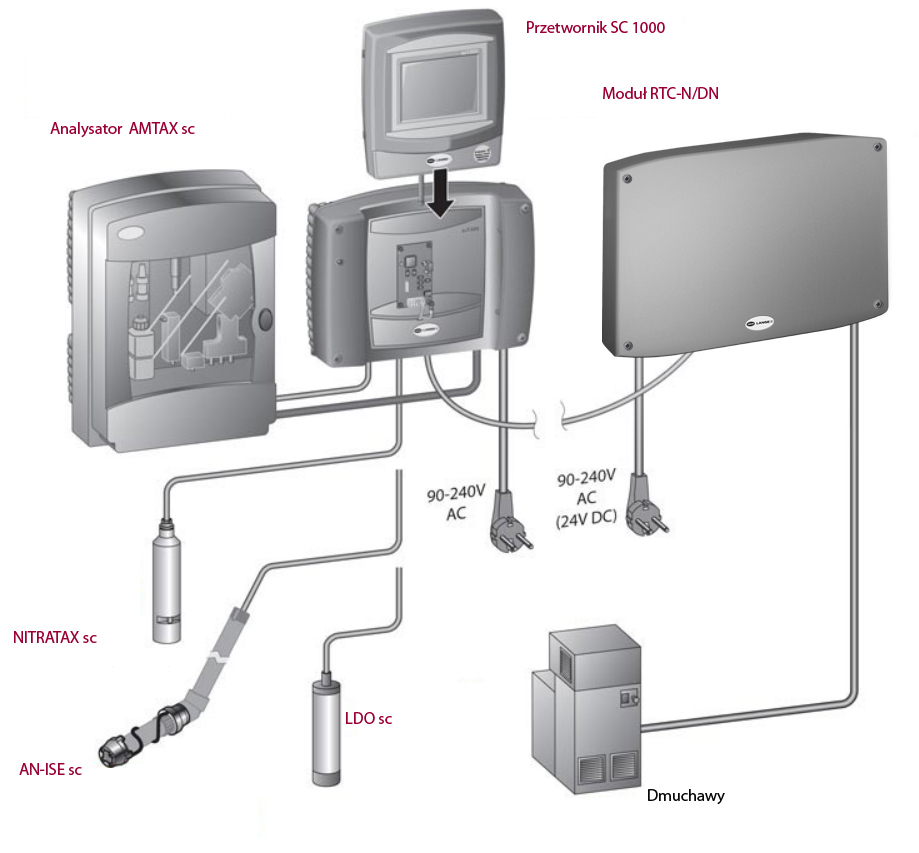
AMTAX sc: High precision process-instrument for the determination of ammonium in water, waste water and activated sludge. Outdoor enclosure. Incl. filter probe with 5m hose. 230V AC/50 Hz power supply.
- Automatic cleaning and calibration
- Wall mountable, rail mountable and mountable on a stand
- With integrated filter probe
- Many additional versions available on request
The sample preparation is done by an integrated sample preparation probe with 5 m heated hose. The filtration probe is operating at 230V. Evaluation and operation with SC 1000 Controller. The analyser is equipped with an insulated enclosure for outdoor installation. The sample can be analysed before any degradation. The ammonium in the sample is first converted to gaseous ammonia. Only the NH3 gas passes through the gas-permeable membrane of the electrode and is detected. This method guarantees a wide measuring range and is less susceptible to cross-sensitivity methods that make use of an ion-selective electrode (ISE). in situ membrane filtration; filter modules are exchangeable.
Back to the top.
SC 1000: Local measurement of several parameters
Probe module for connecting up to 4 SC sensors, with analogue output card with 4 x 0/4-20mA OUTPUT, relay card with 4 break contacts (NC), and EU power cord for 100-240V AC power supply.
- Flexible: individually configurable
- Future-safe: always expandable
- Intuitive operation: display with touchscreen
- Many additional versions available on request
A controller system to which SC sensors can be connected and from which they can be controlled consists of a single SC 1000 display module and one or more SC 1000 probe modules. The system is configured modularly in line with customer-specific requirements and can be expanded at any time with additional measurement stations, sensors, inputs, outputs and bus interfaces.
The probe module is used to connect SC sensors to a measurement station. Several probe modules can be linked to create a SC 1000 network.
Back to the top.
RTC-N/DN
RTC105 N/DN Module, 1-channel, intermittent, VFD control
Control module for load-dependant regulation of nitrification and denitrification times. 1-channel version for intermittently operating WWTPs. With DO step control (6x digital + 2x FU).
- Load-dependent aeration
- Stable nitrogen discharge values
- Reduced energy consumption
- Simple installation
The real-time controller optimises nitrogen elimination at biological waste water treatment plants that are operated either intermittently or in SBR mode (SBR reactors).
Based on the current ammonium and nitrate load, the module automatically calculates when aeration should occur and to what intensity, so that the required discharge values can be reliably met.
The run time of the blowers can also be reduced by setting the load-dependent nitrification and denitrification times, thereby lowering energy costs.
Back to the top.
AN-ISE: Combination sensor for ammonium and nitrate
AN-ISE sc with RFID Low cost ISE combination Ammonium and Nitrate probe (immersion), 10m cable
Carries out continuously direct measurements using an ion-selective electrode. No need for reagents or sample preparation. Compensated interference by potassium and chloride.
- Reliable results for ammonium and nitrate
- Easy handling with CARTRICAL plus
- Simple and intuitive operation
- Always under control
- Rely on Hach's application know how
The special feature of the probe is the CARTRICAL technology. This provides reliable measured values and considerably reduced maintenance time and costs in comparison with conventional ISE probes.
The complete system - SC controller has to be ordered separately - comes from a single supplier. The probe is installed on the side of the tank. The measuring system can be extended to include an automatic cleaning unit with a compressor.
Back to the top.
NITRATAX: Reagent-free method. Multiple beam absorption photometer with a flash lamp, turbidity compensation through reference measurement. Lowered directly into the sample stream (flow-through unit optional).
- UV absorption method-proven, continuous, and precise
- Eliminates reagents, sampling, and sample conditioning
- Self-cleaning probe
- Measurement in activated sludge or in water
- Life-long factory calibration
Stainless steel probe. UV beams are projected across a gap for immediate measurement of the nitrate content in water, wastewater and activated sludge. The measuring windows are cleaned by a wiper. Evaluation by SC controller. The simple mounting and easy handling of the probe is guaranteed by a specially designed tank rim mounting hardware. In order to place the controller near the probe, the tank rim mounting hardware for sc controller should be used. The through-flow variant is used wherever submersible installation is not possible for construction related reasons or the medium makes it necessary to measure a filtered sample (very high TS contents, sewage treatment plant inlet, etc.).
Back to the top.
LDO sc: The new LDO generation - even simpler, even more reliable and even more cost-effective
Immersion or flow-through probe with optical luminescence measuring method. Calibration-free & drift-free.
- Extremely reliable - 36-month warranty on probe
- The optimised temperature sensor and the new 3D factory calibration make O2 measurement even more accurate
- No electrolyte or membrane changes necessary
- Remote functions for simple and convenient data transfer via Internet and SMS
No electrolyte or membrane changes due to the optical measurement method. The new LDO probe ensures there is only a minimal amount of maintenance. The luminescence method means the measurement is unaffected by any type of interference.
Years of practical experience have shown that this method completely overcomes the disadvantages of traditional electrochemical O2 measurement methods.
Back to the top.
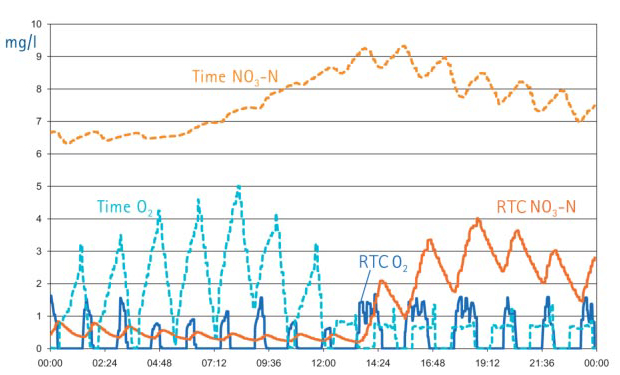 Okresowe zakłady oczyszczania ścieków korzystające z tradycyjnych systemów kontroli czasu mają poważną wadę: działają, nie uwzględniając obciążenia. Napowietrzanie jest aktywowane lub dezaktywowane przez system przez wstępnie zdefiniowany okres czasu. Zbyt wiele tlenu oznacza zbędne koszty energii i jest również niekorzystne dla denitryfikacji. Ilustracja ta przedstawia znaczne różnice między wartościami amoniaku i azotanu wytwarzane przez tradycyjny system kontroli czasu oraz tymi, które są wytwarzane przez zróżnicowane systemy kontroli.
Okresowe zakłady oczyszczania ścieków korzystające z tradycyjnych systemów kontroli czasu mają poważną wadę: działają, nie uwzględniając obciążenia. Napowietrzanie jest aktywowane lub dezaktywowane przez system przez wstępnie zdefiniowany okres czasu. Zbyt wiele tlenu oznacza zbędne koszty energii i jest również niekorzystne dla denitryfikacji. Ilustracja ta przedstawia znaczne różnice między wartościami amoniaku i azotanu wytwarzane przez tradycyjny system kontroli czasu oraz tymi, które są wytwarzane przez zróżnicowane systemy kontroli.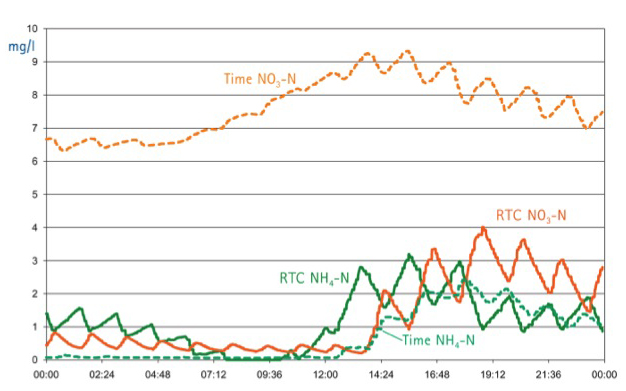
Ograniczenia tradycyjnych systemów kontroli stają się widoczne po każdorazowej zmianie obciążenia, co może mieć miejsce kilka razy dziennie. Podczas faz niskiego obciążenia cykle napowietrzania, które są zbyt częste i zbyt długie, wiążą się z nadmiernym stężeniem tlenu i spowalniają proces denitryfikacji. Wyniki pokazane na schematach zostały pobrane jednocześnie, a w identycznych sytuacjach z dwóch różnych scenariuszy automatycznych. Jeden zestaw wyników został pobrany z RTC–N/DN, a jeden z tradycyjnego systemu kontroli czasu. Ta ilustracja przedstawia, jak stromo rośnie wartość azotanu w kontrolowanym scenariuszu.
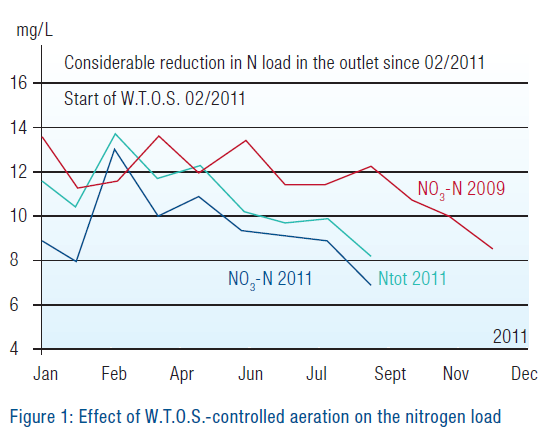
Eliminowanie szczytowych obciążeń amonu z wody procesowej
Pracownicy w zakładzie w Kornwestheim od lat poszukują sposobów na optymalizację zużycia energii i zredukowania obciążenia azotem. Jednak w przypadku korzystania z systemu kontroli napowietrzania, który opiera się wyłącznie na wartościach stężenia tlenu, ich starania napotykają na pewne ograniczenia. Po dodaniu wody procesowej wysokie szczyty obciążenia amoniakiem prowadzą do zwiększenia obciążenia azotem na wyjściu.
Chcesz wiedzieć, z jakie jest rozwiązanie?
Przeczytaj tutaj pełny raport o zastosowaniach.
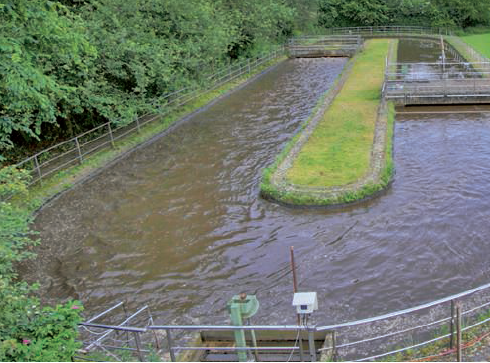 Wysokie wartości azotanów podczas okresów niskiego obciążenia
Wysokie wartości azotanów podczas okresów niskiego obciążeniaW oczyszczalni ścieków w Villau stała kontrola czasu napowietrzania nie może zostać wdrożona wystarczająco precyzyjnie, by obsłużyć zmieniające się poziomy obciążenia. Prowadzi to do niepotrzebnych wysokich wartości azotanów. szczególnie w fazach niskiego obciążenia. Ponadto ogólne zużycie energii jest wysokie.
Chcesz wiedzieć, z jakie jest rozwiązanie?
Przeczytaj tutaj pełny raport o zastosowaniach.
Stellen Sie sicher, dass Ihre Anlage effizient arbeitet und die Wasserqualität das ganze Jahr ohne außerplanmäßige Ausfallzeiten überwacht wird.
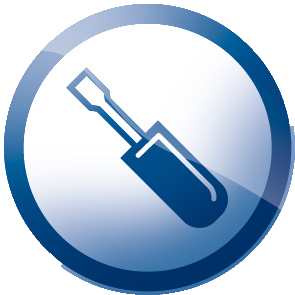 |
Für Messgeräte ist die Wartung genauso wichtig wie die Inspektion für ein Auto: sie spart auf Dauer nicht nur Geld, sondern garantiert einen störungsfreien Einsatz und zuverlässige Messergebnisse. Wir bieten flexible Wartungsverträge, die auf Ihre Bedürfnisse angepasst sind, sowie die Möglichkeit, die Gewährleistung auf bis zu 5 Jahre zu verlängern. |
Jetzt weitere Informationen anfordern!




